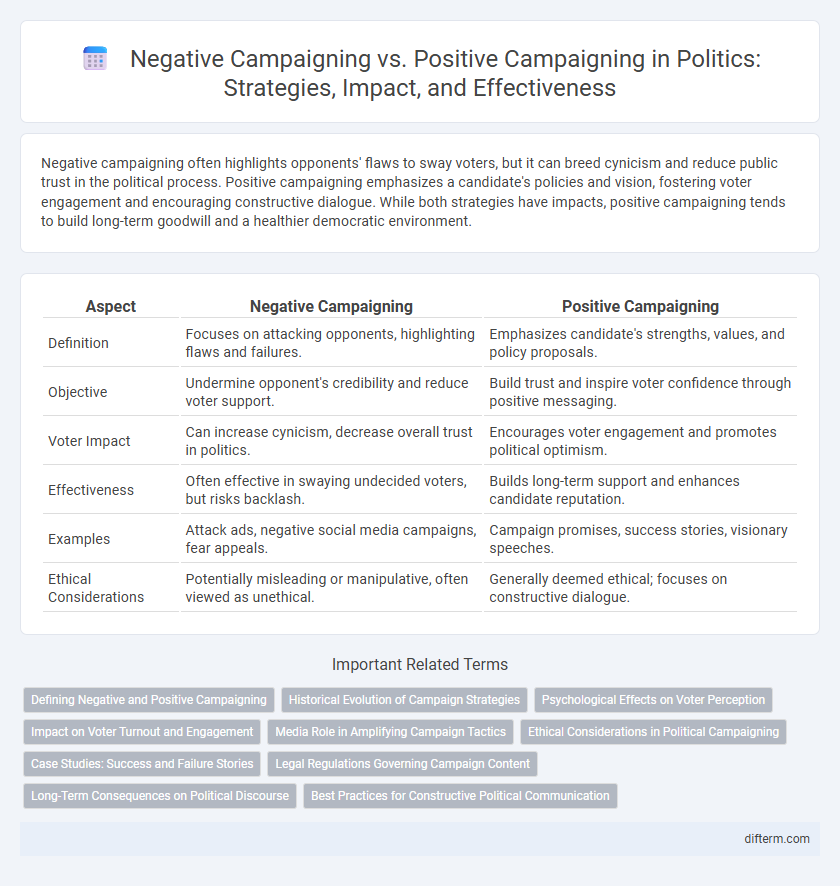Negative campaigning often highlights opponents' flaws to sway voters, but it can breed cynicism and reduce public trust in the political process. Positive campaigning emphasizes a candidate's policies and vision, fostering voter engagement and encouraging constructive dialogue. While both strategies have impacts, positive campaigning tends to build long-term goodwill and a healthier democratic environment.
Table of Comparison
| Aspect | Negative Campaigning | Positive Campaigning |
|---|---|---|
| Definition | Focuses on attacking opponents, highlighting flaws and failures. | Emphasizes candidate's strengths, values, and policy proposals. |
| Objective | Undermine opponent's credibility and reduce voter support. | Build trust and inspire voter confidence through positive messaging. |
| Voter Impact | Can increase cynicism, decrease overall trust in politics. | Encourages voter engagement and promotes political optimism. |
| Effectiveness | Often effective in swaying undecided voters, but risks backlash. | Builds long-term support and enhances candidate reputation. |
| Examples | Attack ads, negative social media campaigns, fear appeals. | Campaign promises, success stories, visionary speeches. |
| Ethical Considerations | Potentially misleading or manipulative, often viewed as unethical. | Generally deemed ethical; focuses on constructive dialogue. |
Defining Negative and Positive Campaigning
Negative campaigning involves candidates attacking opponents' character, policies, or past actions to undermine voter confidence, while positive campaigning emphasizes promoting a candidate's own strengths, values, and policy proposals to inspire and engage voters. Negative campaigning often uses fear, criticism, and controversy to sway public opinion, whereas positive campaigning relies on hope, solutions, and vision to build trust and support. Understanding the strategic use of both approaches is crucial for analyzing election dynamics and voter behavior.
Historical Evolution of Campaign Strategies
Negative campaigning emerged prominently in the late 19th century with smear tactics targeting opponents' character, while positive campaigning emphasized policy achievements and inspiring vision. Throughout the 20th century, especially during television's rise, negative ads grew more sophisticated, leveraging emotional appeals and media reach to sway voters. Recent trends show a blend of both strategies, as campaigns balance attack ads with messages of hope to maximize voter engagement and turnout.
Psychological Effects on Voter Perception
Negative campaigning often triggers heightened emotional responses such as fear and anger, which can lead to increased voter polarization and cynicism toward political candidates. Positive campaigning tends to foster trust, optimism, and a sense of political efficacy, enhancing voter engagement and long-term candidate favorability. Studies reveal that while negative ads may capture immediate attention, they often reduce overall voter turnout and degrade perceptions of the political system.
Impact on Voter Turnout and Engagement
Negative campaigning often depresses voter turnout by fostering cynicism and disengagement, reducing trust in political institutions. Positive campaigning encourages higher voter engagement by promoting policy-focused discussions and inspiring optimism about candidates' visions. Studies show that electorates exposed to constructive messaging participate more actively in elections and civic activities.
Media Role in Amplifying Campaign Tactics
Media outlets significantly influence the effectiveness of negative and positive campaigning by shaping public perception through selective coverage and framing. Negative campaigning often receives more intense media attention due to its sensational nature, amplifying controversy and voter distrust. Conversely, positive campaigning struggles to gain equivalent visibility, limiting its ability to foster voter engagement and promote constructive political discourse.
Ethical Considerations in Political Campaigning
Ethical considerations in political campaigning demand transparency, honesty, and respect for voters, which positive campaigning tends to uphold through policy-focused messages and constructive dialogue. Negative campaigning, while effective in highlighting opponents' flaws, often involves misinformation, personal attacks, and divisive rhetoric that erode public trust and democratic values. Prioritizing ethical standards fosters informed voter decisions and strengthens the integrity of the political process.
Case Studies: Success and Failure Stories
Negative campaigning often captures voter attention by highlighting opponents' flaws, as demonstrated in the 2016 U.S. presidential election where aggressive attacks significantly influenced public perception. Conversely, positive campaigning, seen in Justin Trudeau's 2015 Canadian election strategy, fosters voter goodwill and long-term support by emphasizing policies and vision. However, cases like the 2004 U.S. presidential election reveal that negative tactics can backfire, leading to voter backlash and loss of trust.
Legal Regulations Governing Campaign Content
Legal regulations governing campaign content vary significantly across jurisdictions, often imposing strict limits on negative campaigning to prevent defamation, misinformation, and election interference. Electoral commissions and courts typically enforce rules that require factual accuracy, prohibit hate speech, and mandate transparency about funding sources in campaign advertisements. Compliance with these laws aims to promote fair competition and protect voters from manipulative or harmful political messaging.
Long-Term Consequences on Political Discourse
Negative campaigning can erode public trust in political institutions, fostering cynicism and disengagement among voters over time. Positive campaigning promotes constructive dialogue and civic participation by emphasizing policy solutions and shared values. Sustained reliance on negative tactics risks polarizing societies and undermining the quality of democratic debate.
Best Practices for Constructive Political Communication
Effective political communication prioritizes transparency, respect, and factual accuracy to foster trust and voter engagement. Best practices emphasize constructive messaging that highlights candidates' policies and achievements rather than attacking opponents, reducing polarization and promoting informed decision-making. Employing positive narratives and data-driven arguments enhances the democratic process by encouraging civil discourse and increasing public confidence in electoral outcomes.
negative campaigning vs positive campaigning Infographic

 difterm.com
difterm.com